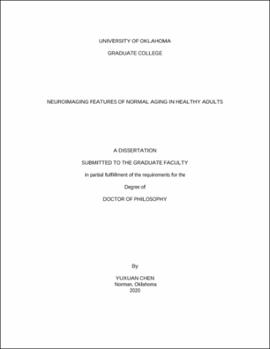| dc.contributor.advisor | Yuan, Han | |
| dc.contributor.author | Chen, Yuxuan | |
| dc.date.accessioned | 2020-07-29T20:15:19Z | |
| dc.date.available | 2020-07-29T20:15:19Z | |
| dc.date.issued | 2020-07-30 | |
| dc.identifier.uri | https://hdl.handle.net/11244/325319 | |
| dc.description.abstract | Neurodegenerative disorders, such as Alzheimer’s disease (AD), have an enormous impact on the quality of life in millions of aging adults and bring a daunting financial burden to the society. Towards understanding the mechanism of AD, recent studies have emphasized the changes in large-scale brain networks related to healthy aging, with the ultimate purpose to aid in differentiating normal neurocognitive aging from neurodegenerative disorders that also arise with age. In this dissertation, my work aimed to establish a neuroimaging-based biomarker that can indicate the episodic memory performance in humans, which in the long term can be a tool to monitor the memory decline in the normal aging process early stage of Alzheimer’s disease. In particular, my work focused on using wearable neural technology, i.e., electroencephalography (EEG) and functional near-infrared spectroscopy (fNIRS), to investigate the association of memory and brain connectivity pattern of default mode network (DMN).
Chapter 2 of my dissertation showed that higher brain connectivity in the posterior cingulate / precuneus area of DMN was associated with lower performance on an episodic memory task. The findings demonstrate the feasibility of using electrophysiological imaging to characterize large-scale brain networks and suggest that network connectivity changes are associated with normal aging.
Furthermore, Chapter 3 of my dissertation investigated the confounding effect of vigilance on brain network connectivity at awake resting state. I examined the characteristics of the global signal by using fNIRS and correlated the amplitude of the fNIRS global signal with vigilance measured by EEG. Results found that body positions' factor significantly affected the amplitude of the resting-state fNIRS global signal, prominently in the frequency range of 0.05 Hz - 0.1 Hz but only marginally in the very-low-frequency range of less than 0.05 Hz. More importantly, the amplitude of the global signal in the very-low-frequency range of less than 0.05 Hz exhibited a significant negative correlation with EEG vigilance measures. For the first time, our study revealed that vigilance as a neurophysiological factor modulates the resting-state dynamics of fNIRS, which have important implications for understanding the noises and neural origins in fNIRS and possibly in fMRI signals.
In Chapter 4, my work continues to search for approaches that can minimize the confounding effect of vigilance other than regress the entire vigilance, which contains physiological noise and the neuronal component. By implementing new connectivity metrics, the significant association between memory and brain connectivity is consistent with our previous finding. More importantly, the new metrics improved the significance of the difference between two age groups and the association between age and brain connectivity. The approach of removing the confounding part of vigilance measure will increase the accuracy and sensitivity of EEG brain connectivity and indicate broad application prospects in normal and abnormal aging studies.
In summary, my dissertation systematically demonstrates the current application of portable non-invasive neuroimaging tools in the field of aging and Alzheimer’s study. My work has also examined the confounding effect of vigilance on network connectivity, and further proposed a solution of calibrated network connectivity towards a more accurate neuroimaging biomarker for memory. Our results suggest that EEG would be an effective, sensitive neuroimaging tool to characterize electrophysiological features of normal aging in the human brain's large-scale networks. My findings based on multimodal neuroimaging also provide important implications in understanding the neuroimaging literature on memory and aging. | en_US |
| dc.language | en_US | en_US |
| dc.rights | Attribution-NonCommercial-NoDerivatives 4.0 International | * |
| dc.rights.uri | https://creativecommons.org/licenses/by-nc-nd/4.0/ | * |
| dc.subject | Engineering, Biomedical. | en_US |
| dc.subject | Engineering, Electronics and Electrical. | en_US |
| dc.subject | Neuroimaging | en_US |
| dc.title | Neuroimaging features of normal aging in healthy adults | en_US |
| dc.contributor.committeeMember | Dyer, John | |
| dc.contributor.committeeMember | Wenger, Michael | |
| dc.contributor.committeeMember | Xiang, Liangzhong | |
| dc.contributor.committeeMember | Zheng, Bin | |
| dc.date.manuscript | 2020-07 | |
| dc.thesis.degree | Ph.D. | en_US |
| ou.group | Gallogly College of Engineering::School of Electrical and Computer Engineering | en_US |
| shareok.orcid | https://orcid.org/0000-0003-1977-3241 | en_US |
| shareok.nativefileaccess | restricted | en_US |

